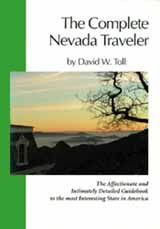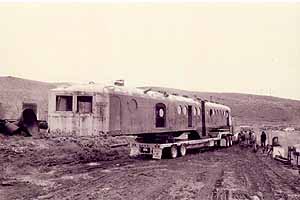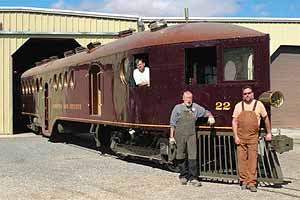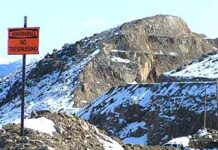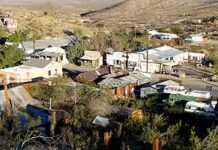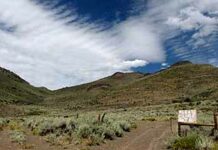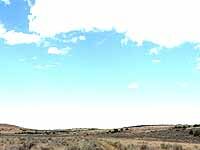|
What They’re saying About Us |
| Sign Up for our NevadaGram here. |
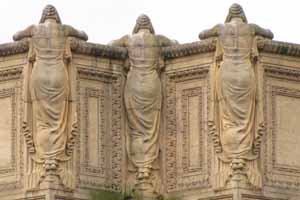
We have been to Bullhead City Arizona, to Wendover Utah and Markleeville California among other cross-border destinations, and we consider Lake Tahoe our lake, even though two-thirds of it is in California. This time, though, we left Nevada behind and went all the way to San Francisco. This Trip Report is a departure — our first report on a voyage out of state.
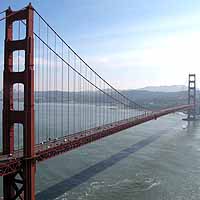 We had a personal agenda to carry out, and no particular Nevada angle to pursue other than the long and close association between San Francisco and the Comstock, Las Vegas and Los Angeles. That started with the mines and was manifested most recently in the 1960s by the San Francisco psychedelic guitar bands that created a sensation when they played at Virginia City’s Red Dog Saloon.
We had a personal agenda to carry out, and no particular Nevada angle to pursue other than the long and close association between San Francisco and the Comstock, Las Vegas and Los Angeles. That started with the mines and was manifested most recently in the 1960s by the San Francisco psychedelic guitar bands that created a sensation when they played at Virginia City’s Red Dog Saloon.
We had read a recent column by Carl Nolte in the S.F. Chronicle about the renewed popularity of the Pisco Punch, which was the San Francisco treat before Rice-A-Roni. It dates from the gold rush, when Peruvian grape brandy, called Pisco after its port of origin, was the common grog, widely distributed. Pour some in a glass, add a few potions and potations and you have a Pisco Punch.
Inspired by the article, and enthusiasts for history and tradition, we organized a pisco pub crawl to explore the varieties of this pioneer refreshment. We thought of sipping a cocktail from the Gold Rush years might open the door to time travel, and we began our search for early San Francisco at the Pisco Latin Lounge on Market Street, with a round of Pisco Punches.
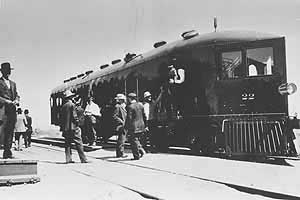 The new McKeen car taking on passengers in Carson City, 1910. In 1910 The Virginia & Truckee Railroad purchased McKeen Motor Car No. 22 at a cost of $22,000 (Between 1905 and 1920 about 160 McKeen Motor Cars were built for use in the USA, Mexico and Australia). Ours was delivered to the railroad at Carson City on May 9, 1910 and immediately put into service between Reno and Minden. The McKeen was a bit of an anomaly when it originally ran on the Virginia & Truckee line. It was self-propelled with a noisy engine and unique shape, being rounded on one end and pointed on the other, and boasted round porthole windows. To top it off, it was painted a very rich wine color with gold lettering and striping. In 1945 and with more than 530,000 miles of travel, it was finally retired and sold for use as a diner at the southern edge of Carson City. In more recent years it served as the office for Al’s Plumbing. In 1995 the car was donated to the Nevada State Railroad Museum by the Bernhard family of Carson City and has now been completely restored. May 10, 2010 will mark 100 years to the day of the car’s arrival in Carson City.
Now the Nevada State Railroad Museum will celebrate the centennial anniversary of its arrival in Carson City by showcasing the restoration of the historic car. As a part of the celebration, the museum is seeking individuals who remember riding the McKeen Car during its original service between 1910 and 1945. “We know of some existing residents who rode the McKeen car as children or young adults,” said Peter Barton, Acting Administrator of Museums & History. “We suspect there may be others out there, considering the McKeen Car was in service for over 35 years.” Individuals who remember riding the car are urged to contact Teresa Moiola by telephone (at 775-687-8323) or e-mail to share their story and participate in the upcoming commemorative festivities. Presumably they’ll have the chance to ride it again if they want to, as this will be the first time the McKeen Car runs under its own power while carrying passengers since it was decommissioned . . . |
Because we’d already had a long day, our pub crawl slowed to a creep and then stopped altogether. The experience wasn’t all that transcendent — cousin Ian switched to a Martini after his first Pisco Punch — and we stayed firmly rooted in the 21st century. But it tasted good, and I think that anyone who makes any claim or pretension about being interested in Western history had better have one or two.
Our main line of business was to spend some time with our Comstock girls now living in the city — Margaret and Emily from Silver City and Allie from Gold Hill, all recent college graduates, sharing an apartment in the city together — just like in a tv show. And they are like starlets, these three lively, lovely girls getting along in the big city.

So I almost gave up on our San Francisco excursion as being the topic of a NevadaGram. I didn’t want to subject you to a dad’s goopy writing about his delightful daughter, his charming nieces. What fun is that to read about?
I began to think I might not get a NevadaGram out of San Francisco after all.
We visited the California Historical Society — well, they were having a wine tasting — because the featured exhibit was of Emperor Norton, the self-proclaimed Emperor of the United States and Protector of Mexico. This remarkable personality was accepted into the weave of the young city and came to personify the pioneer era of brash young San Francisco. What other city in America supported an emperor of its own?
Herb Caen delighted in the Norton tale, and he told it many times. And here in a glass case is Norton’s cane, a knobbly stick surprisingly short — he must have been a small man, doubtless comical-looking with his two leashed hounds and the elaborate military uniform he wore, the feathers in his hat.
We went to the Pied Piper bar in the Palace Hotel, another icon of old San Francisco with its famous Maxwell Parrish mural. This Palace Hotel opened in 1909, built on the ashes of the original which burned after the earthquake in 1906. Enrico Caruso was a guest that night and after the quake had wrought its devastation, he went running up Market Street in his pajamas with a bellman from the hotel trundling his big steamer trunk alongside.
Interesting, but there’s no Nevada in it.
On Saturday morning we met at Louie’s for a farewell breakfast. Louie’s is across the boulevard from Adolph
Sutro’s estate, and it overlooks the great concrete ruins of the Sutro Baths, the 19th century version of Wet ‘n’ Wild, once a famous landmark of the city. Along with the pancakes, our waitress brought us news of the earthquake in Chile, and that a tsunami warning had been issued for the California coast.
Immediately we sprang into action. Robin and I ran our last-minute errands in the city while the girls ambled down to the Cliff House — another iconic relic of the old city — and claimed a table with a magnificent ocean view. When we rejoined them the tsunami was imminent.
It dawned on me as we waited that here was a Nevada connection. The Sutro Baths were a landmark in old San Francisco. Adolph Sutro had been a merchant in Dayton when he was inspired by the vision of a four-mile-long tunnel to drain the Comstock mines. He successfully promoted the project, which was completed in 1878, and which eventually made him a millionaire.
Like other Nevadans before him, he took his wealth to San Francisco, invested in real estate, ran successfully for Mayor, built an impressive home overlooking the ocean (and his famous Bath House), and presumably lived happily ever after.
We waited and we waited. There were at least 50 people down at sea level wandering the ruins of the old swimming pools, and a hundred or more in the water or on the sand at Ocean Beach to the south. But there was no tsunami and not one single person got swept away before our eyes. My frustration was assuaged by the beverage menu, which offered some more history lessons, including the Sazerac Cocktail, another popular bibulosity of the 19th century. Like the Pisco Punch it is quite palatable, but on the sweet side.
So we came home to Nevada without the NevadaGram discovery I’d hoped to make. With all the history we share, I couldn’t find the thread that would lead me into old San Francisco.
A week later a friend sent the video below. Its origin isn’t clear, and its been variously dated, but it is obviously a movie taken from a cable car moving east along Market Street toward the Ferry Building not long before the earthquake and fire. This is the San Francisco of our great-great-grandparents’ time,
gone forever, and it is thrilling — magical — to see it . . . very nearly touch it.
Quick notes from beyond the mountains: Here is a unique event in Laughlin that promises to be highly entertaining.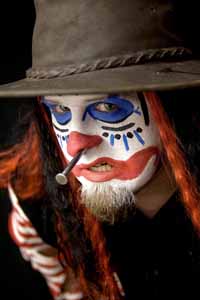
American Madman Ses Carny and torture stunt artist Professor Chumley are teaming up to present “The History of the Sideshow” at Granny’s Restaurant, at the Pioneer Hotel and Gambling Hall in Laughlin on Tuesday, April 20th. This stirring lecture/demonstration carries the history of American sideshow from the days of P.T. Barnum up to the present-day. Tickets can be purchased at the Pioneer Cowboy Store, and at St. John the Baptist Catholic Church at 3055 El Mirage Way in Laughlin. Tickets are $8; doors open at 5:30 pm, show starts at 6:30. For more information, call Father Charlie (magic and sideshow enthusiast!) at 702-298-0440 . . .
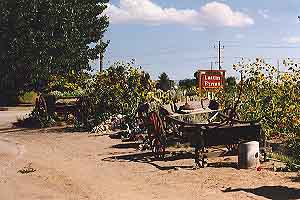 In Fallon on Saturday, April 24 you can enjoy a dreamy spring day in the country at Tractors & Truffles, an agriculture and arts event beginning at Lattin Farms at [time] with lunch and a liesurely farm tour, a wine tasting at Churchill Vineyards, and then a gourmet dinner prepared by three award-winning chefs. After dinner the day concludes with a performance by Blues Music Award winner and Mississippi blues artist Rory Block at the Oats Park Arts Center. Cost: $100 per person, discounted rates available at local lodgings . . .
In Fallon on Saturday, April 24 you can enjoy a dreamy spring day in the country at Tractors & Truffles, an agriculture and arts event beginning at Lattin Farms at [time] with lunch and a liesurely farm tour, a wine tasting at Churchill Vineyards, and then a gourmet dinner prepared by three award-winning chefs. After dinner the day concludes with a performance by Blues Music Award winner and Mississippi blues artist Rory Block at the Oats Park Arts Center. Cost: $100 per person, discounted rates available at local lodgings . . .
At 3 pm on the third Saturday of each month The Erotic Heritage Museum in Las Vegas hosts The Afternoon Delight Naughty Variety Show. Talented performers from all over the Las Vegas Valley come to utilize the artistic freedom the museum provides. April’s headliner (on the 17th) is XXX Comedian Schree Lewis, who will perform along with magician Bizzaro Demented and Suzie Homewrecker’s guitar and singing. Hostess Amanda enjoys stretching the 1st amendment right so freely displayed and celebrated at the museum. Also offered: a “special” body painted celebration of The Bill Of Rights. $10 includes tea and treats . . .
The Courthouse Museum on Main Street in Genoa is opening early this year, on April 28th, so as not to miss the crowds attending the Genoa Cowboy Poetry and Music Festival that weekend. The official opening will be Saturday, May 1st, with Marilyn Elligot teaching spinning techniques on the porch of the Museum at 11 am and 1 pm. The Courthouse Museum is open daily, 10 am to 4 pm, May through October. 775-782-4325 . . . The 7th annual Reno River Festival take place May 7-9 along the Truckee River in downtown Reno with adventures both in and out of the water with kayaking, stand up paddle board races and the 3rd annual Run Amuck competition. The Siena Hotel on the south bank of the Truckee is host for the event.
Overheard in the Pied Piper Bar of The Palace Hotel in San Francisco: “Oh Melanie, you would brighten even the Apocalypse.”
Happy Highways,




